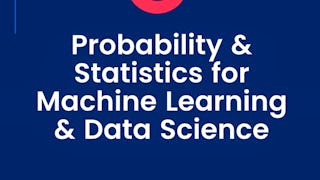This course offers a comprehensive introduction to the mathematical principles that form the foundation of artificial intelligence and machine learning. Designed for learners with a variety of academic backgrounds, the course bridges essential mathematical concepts with real-world AI applications, empowering students to understand and implement mathematical techniques critical for AI development.


您将获得的技能
- Artificial Intelligence and Machine Learning (AI/ML)
- Statistical Analysis
- Exploratory Data Analysis
- Mathematical Modeling
- Regression Analysis
- Data Analysis
- Applied Mathematics
- Bayesian Statistics
- Probability
- Algebra
- Descriptive Statistics
- Artificial Intelligence
- Data-Driven Decision-Making
- Machine Learning Algorithms
- Linear Algebra
- Probability Distribution
- Calculus
- Integral Calculus
- Advanced Mathematics
- Statistics
要了解的详细信息

添加到您的领英档案
48 项作业
了解顶级公司的员工如何掌握热门技能

该课程共有12个模块
Dive into the world of essential functions, the cornerstone of mathematical modeling in artificial intelligence! This module introduces you to the powerful language of functions, enabling you to explore and describe relationships between variables. From understanding basic function notation to modeling real-world phenomena, you’ll gain the tools to analyze, interpret, and manipulate the building blocks of AI-powered systems. By mastering these foundational concepts, you’ll be ready to tackle more complex mathematical structures that drive modern AI applications. This module is your gateway to understanding the mathematics that underpins artificial intelligence. Let’s begin this exciting journey into the essential tools shaping the AI-driven future!
涵盖的内容
8个视频6篇阅读材料5个作业
Data is the lifeblood of artificial intelligence, and understanding how to describe and visualize it is essential for uncovering meaningful insights. This module focuses on the foundational statistical concepts that empower you to summarize and analyze datasets effectively. You’ll learn how to describe the central tendencies and variability of data, as well as create compelling visual representations that highlight patterns and relationships. By developing these skills, you’ll gain a deeper appreciation for the stories data can tell and build the confidence to interpret real-world datasets—a critical step in making data-driven decisions and designing AI systems. Whether you’re identifying trends, assessing variability, or uncovering hidden connections, the ability to describe and visualize data is a cornerstone of working with AI. Let's begin.
涵盖的内容
4个视频3篇阅读材料3个作业
This module introduces the powerful tools of vectors, matrices, and linear equations, which form the backbone of many AI and machine learning algorithms. You’ll explore how these mathematical constructs are used to represent and solve systems of linear equations, a fundamental step in understanding linear transformations, optimization problems, and more. Throughout the module, you'll work with augmented matrices, learn to perform row operations, and explore the geometry of vectors in multi-dimensional space. You’ll also uncover how matrices and vectors interact through operations like multiplication, and how to use the inverse of a matrix to solve matrix-vector equations efficiently. Mastering these concepts is critical for anyone aspiring to work in AI, as they are the foundation for algorithms ranging from data preprocessing to neural network optimization. With these skills, you’ll be equipped to handle complex systems of equations and develop an intuitive understanding of the mathematical structures that power AI. Let's begin.
涵盖的内容
5个视频5篇阅读材料6个作业
This module delves into the practical application of linear equations to model and analyze relationships between variables. Linear regression, one of the most widely used techniques in statistics and machine learning, is at the core of this exploration. You'll learn how to interpret regression coefficients, evaluate the strength and direction of relationships, and assess the quality of a linear model’s fit to a dataset. The module also introduces multiple linear regression, enabling you to analyze how multiple factors simultaneously influence an outcome. From examining scatter plots and two-variable relationships to predicting outcomes using regression equations, you’ll gain hands-on experience applying these techniques to real-world data. By the end of this module, you’ll be equipped with the tools to uncover trends, make predictions, and quantify relationships in complex datasets—skills that are indispensable in the data-driven world of AI. Linear regression not only serves as a gateway to advanced statistical modeling but also forms a foundational building block for understanding machine learning algorithms. Let's begin.
涵盖的内容
4个视频3篇阅读材料3个作业
This module introduces linear transformations, a fundamental concept in linear algebra that bridges geometry and algebra. By representing transformations with matrices, you’ll explore how vectors are scaled, rotated, reflected, or otherwise mapped from one space to another. Understanding these operations is critical for advanced applications in AI, including neural networks, computer graphics, and data dimensionality reduction. You’ll begin by identifying linear transformations and exploring their properties, such as linear independence, one-to-one mappings, and onto mappings. You'll also learn how to compute the images and preimages of vectors under transformations and how to construct the standard matrix for a given transformation. These concepts provide a framework for understanding how data and spaces can be transformed mathematically—a key step in building AI models. By the end of this module, you’ll have a strong grasp of the algebraic and geometric interpretations of linear transformations, empowering you to work with higher-dimensional data and solve complex problems in AI and beyond. Let's begin.
涵盖的内容
3个视频3篇阅读材料3个作业
In this module, you’ll dive into the geometry of vectors and uncover the relationships that define their interactions in space. Vectors are more than just arrows in a diagram—they’re essential tools for analyzing distances, angles, and directions in multi-dimensional spaces. These concepts are critical for understanding modern AI techniques, including classification algorithms and dimensionality reduction. You’ll begin by exploring the fundamentals of vector geometry, such as calculating lengths, distances, and angles using the dot product. From there, you’ll delve into subspaces, orthogonality, and the construction of orthogonal and orthonormal bases, tools that help simplify complex spaces. The module concludes with real-world applications, including vector-based projections and their role in machine learning algorithms like k-nearest neighbors. By mastering vector geometry, you’ll gain the mathematical intuition to analyze and interpret high-dimensional data, opening the door to advanced AI applications and powerful geometric insights. Let's begin.
涵盖的内容
4个视频4篇阅读材料5个作业
This module explores two pivotal concepts in linear algebra: determinants and eigenvectors. These mathematical tools are integral to understanding how matrices behave and are foundational to many advanced AI techniques, including dimensionality reduction, graph algorithms, and stability analysis. You’ll start with determinants, learning how to compute them and uncover the valuable insights they provide about matrices, such as invertibility and volume scaling. Then, you’ll delve into eigenvalues and eigenvectors—powerful concepts that reveal the intrinsic properties of linear transformations. Through step-by-step exploration, you’ll learn how to determine eigenvalues and eigenvectors, solve the characteristic equation, and analyze eigenspaces. The module culminates with an application of eigenvalues and eigenvectors in machine learning, particularly in dimensionality reduction techniques like Principal Component Analysis (PCA). By mastering these concepts, you’ll gain the tools to analyze complex systems and prepare for deeper explorations into the mathematics that power AI. Let's begin.
涵盖的内容
3个视频3篇阅读材料4个作业
This module introduces the foundational principles of discrete probability distributions, empowering you with the essential tools to understand and apply probability in artificial intelligence. Through examples and applications, your will explore how probabilistic thinking enables AI systems to make decisions under uncertainty, classify data, and model complex scenarios. You will learn to use Bayes’ Rule as a powerful tool for classification, turning raw data into actionable insights for AI applications such as spam detection and medical diagnostics. You will master techniques to compute the likelihood of single events, compound events, and their complements with precision, as well as evaluate scenarios involving multiple events using addition rules. The ability to distinguish between discrete and continuous random variables will lay the groundwork for defining and interpreting probability mass functions (PMFs) and cumulative distribution functions (CDFs), critical components in modeling AI systems. Probability theory is the backbone of AI, driving algorithms that enable machines to predict, classify, and make decisions. This module bridges theory and application, equipping students with the skills to implement probabilistic methods in real-world AI problems. Let's begin.
涵盖的内容
4个视频6篇阅读材料4个作业
In this module, you’ll uncover the dynamic world of derivatives and rates of change, where mathematics meets motion, growth, and optimization. By exploring the concept of a derivative, you’ll gain a powerful tool to describe how quantities change over time or in relation to one another—an essential foundation for understanding AI algorithms that rely on optimization and learning. You’ll learn to interpret the derivative as the slope of a curve and a measure of instantaneous change, connecting abstract mathematics to tangible applications in fields like physics, economics, and machine learning. From computing derivatives of common functions to understanding higher-order derivatives, this module provides you with the mathematical insight to describe, predict, and optimize change. This module bridges the gap between theory and application, showing you how derivatives underpin key AI techniques such as gradient descent and optimization algorithms. By mastering these concepts, you’ll be ready to tackle complex problems in AI and data science with confidence and clarity. Let's begin.
涵盖的内容
4个视频4篇阅读材料3个作业
In this module, you’ll delve into optimization, a cornerstone of artificial intelligence and machine learning. From identifying the best solutions to complex problems to understanding how clustering algorithms organize data, optimization is at the heart of AI's decision-making power. You’ll explore how to apply differentiation to solve real-world optimization problems, discovering how mathematical insights can drive practical solutions. By learning to locate critical numbers, determine maximum and minimum values, and analyze concavity and inflection points using the second derivative, you’ll build the tools to navigate and interpret the behavior of functions. These skills will empower you to model and refine systems, whether you’re minimizing costs, maximizing efficiency, or clustering data for AI applications. This module connects the mathematical principles of optimization to the challenges faced in AI, such as clustering data into meaningful groups and fine-tuning algorithms for peak performance. By mastering these techniques, you’ll be equipped to tackle the complex problems that define AI and its applications. Embark on this exploration of optimization and unlock the key to AI’s ability to learn and improve. Let's begin.
涵盖的内容
3个视频5篇阅读材料4个作业
How do self-driving cars navigate uncertain environments? How does AI predict the likelihood of an event? These questions lie at the heart of this module, where you’ll explore how calculus and probability work together to model and quantify uncertainty. You’ll delve into the normal distribution, the cornerstone of statistical modeling, and discover how integrals define probabilities and averages of continuous random variables. By working through real-world examples, such as analyzing rates of change or estimating outcomes, you’ll learn to use calculus as a powerful tool for AI applications. This module emphasizes practical problem-solving, guiding you to compute probabilities, evaluate integrals over infinite intervals, and use numerical methods to approximate solutions. Through these applications, you’ll gain a deeper understanding of how mathematical foundations drive AI systems, equipping you with the skills to tackle challenges in machine learning, robotics, and beyond.
涵盖的内容
6个视频5篇阅读材料4个作业
What makes neural networks learn? How does an AI system find the optimal solution to a problem? In this module, you’ll explore the power of partial derivatives and gradients to uncover the mathematics that drives these processes. You’ll learn how the gradient vector points the way to the steepest ascent or descent, a concept fundamental to optimizing neural networks. By examining real-world applications, such as maximizing rates of change or analyzing multivariable systems, you’ll see how calculus shapes the algorithms behind AI. Through hands-on problems, you’ll compute partial derivatives, interpret their meaning in applied contexts, and use directional derivatives to measure changes in specific directions. Whether you’re training machine learning models or analyzing complex data landscapes, this module equips you with the tools to understand and harness the gradient’s role in AI.
涵盖的内容
2个视频4篇阅读材料4个作业
位教师

从 Data Analysis 浏览更多内容
 状态:免费试用
状态:免费试用 状态:免费试用
状态:免费试用DeepLearning.AI
 状态:免费试用
状态:免费试用DeepLearning.AI
 状态:预览
状态:预览Northeastern University
人们为什么选择 Coursera 来帮助自己实现职业发展




常见问题
To access the course materials, assignments and to earn a Certificate, you will need to purchase the Certificate experience when you enroll in a course. You can try a Free Trial instead, or apply for Financial Aid. The course may offer 'Full Course, No Certificate' instead. This option lets you see all course materials, submit required assessments, and get a final grade. This also means that you will not be able to purchase a Certificate experience.
When you purchase a Certificate you get access to all course materials, including graded assignments. Upon completing the course, your electronic Certificate will be added to your Accomplishments page - from there, you can print your Certificate or add it to your LinkedIn profile.
Yes. In select learning programs, you can apply for financial aid or a scholarship if you can’t afford the enrollment fee. If fin aid or scholarship is available for your learning program selection, you’ll find a link to apply on the description page.
更多问题
提供助学金,

 中
中

